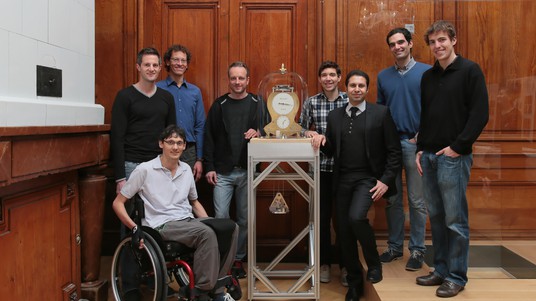The mechanical clock of the 21st century on display in Neuchâtel

The IsoSpring clock© Alain Herzog / 2016 EPFL
A highly innovative mechanical clock invented, designed and set in motion by EPFL will soon be installed in the Neuchâtel city hall. This prototype is equipped with a new type of oscillator, marking a major conceptual shift in the long history of mechanical timekeeping.
Researchers at EPFL’s Instant-Lab in Neuchâtel have developed a prototype of a mechanical clock that operates with a new type of oscillator. The oscillator, unveiled in 2014, was dubbed “IsoSpring” due to its isotropic spring. It replaces conventional clock pendulums and watch spiral spring-balance wheels.
IsoSpring has now been incorporated in a complete functional mechanical clock.
Silent and accurate, the prototype clearly resembles traditional Neuchâtel clocks. EPFL has loaned it to the city of Neuchâtel, and it is now on display in the Pas Perdus room of the town hall, across from a clock made by the famous 19th-century inventor Matthias Hipp.
No more ticking
This clock was entirely thought up and developed by EPFL’s Instant-Lab - Patek Philippe Chair in Micromechanical and Horological Design, led by Professor Simon Henein. This prototype suggests that mechanical timekeepers – watches, carriage clocks and large clocks – may soon be capable of unparalleled performance in terms of chronometric accuracy and power reserve, while still retaining mechanical simplicity.
The IsoSpring concept allows watchmakers to make the leap from conventional timebases with a back-and-forth movement to continuous unidirectional trajectories. Thanks to this breakthrough, time is once again silent and continuous. The oscillator functions without an escapement, the component that produces the stop-and-go motion and the signature ticking sound. Conventional movements have now been radically simplified.
The use of “compliant mechanisms” obviates the need for conventional pivots. This means that there is no friction or wear-and-tear and that no lubrication is necessary. This also reduces energy losses in the oscillator by more than one order of magnitude.
EPFL has filed two patent applications, and the researchers are now working on miniaturizing their invention. The watchmaking industry is extremely interested in this new oscillator.
An oscillator inspired by the heavens
The rotating mechanism came straight out of Isaac Newton’s 17th-century description of how planets orbit around the sun. “Technically, this invention could have happened in the 17th century. But as far as we know, no one else has thought of it since then,” says Henein, who holds the Patek Philippe Chair and runs Instant-Lab. “That makes our clock both revolutionary and traditional, two factors highly appreciated by the watchmaking industry.”
Neuchâtel, center of horological research
On the IsoSpring clock, a small face displaying hours and minutes sits below a large face showing the fluid and uninterrupted movement of the second hand. The oscillator, which replaces the pendulum, orbits in a horizontal plane on top of the clock.
“This clock embodies history, science, innovation, workmanship and industry,” says Ilan Vardi, co-inventor of IsoSpring. “It is a fitting symbol of the Neuchâtel region, the global center of horological and micromechanical research. It’s easy to forget, but major inventions in timekeeping – such as the quartz watch – took place in this region.”
The opportunity to display the new clock in the heart of the city of Neuchâtel and take the research out of the ivory tower has particular resonance for the researchers at EPFL's Neuchâtel outpost. “We were very warmly welcomed by city officials,” says Henein.
For Christine Gaillard, the Neuchâtel city councilor in charge of education, this project also shows people the “important role played by EPFL in Neuchâtel in innovation and in watchmaking, where tradition and research go hand in hand.”
Links: Patek Philippe Chair in Micromechanical and Horological Design INSTANT-LAB






